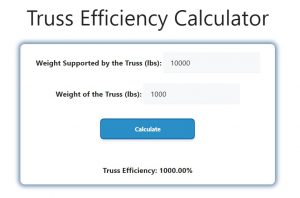About Truss Efficiency Calculator (Formula)
The Truss Efficiency Calculator is a valuable tool used in structural engineering to evaluate the performance of truss designs. Trusses are widely utilized in bridges, roofs, and various frameworks due to their ability to efficiently support loads. Understanding the efficiency of a truss is essential for engineers and architects to ensure safety and stability while optimizing material usage. This article will delve into the formula for calculating truss efficiency, provide step-by-step instructions for using the calculator, and address common questions related to this critical aspect of structural design.
Formula
The formula for calculating truss efficiency is: Etruss = WS / WT * 100, where Etruss represents truss efficiency, WS is the weight supported by the truss, and WT is the total weight of the truss itself.
How to Use
To use the Truss Efficiency Calculator effectively, follow these steps:
- Determine the Weight Supported (WS): Measure or estimate the total weight that the truss is designed to support.
- Measure the Total Weight of the Truss (WT): This includes all materials used in the truss construction.
- Input Values: Enter the values for WS and WT into the calculator.
- Calculate Truss Efficiency: Use the formula Etruss = WS / WT * 100 to compute the efficiency percentage.
Example
Let’s consider an example where a truss supports a weight of 10,000 pounds, and the total weight of the truss itself is 1,000 pounds.
- Input Values:
WS = 10,000 pounds
WT = 1,000 pounds - Apply the Formula:
Etruss = (WS / WT) * 100
Etruss = (10,000 / 1,000) * 100
Etruss = 10 * 100
Etruss = 1000%
In this case, the truss efficiency is 1000%, indicating a highly efficient design, as it supports significantly more weight than its own structure.

FAQs
- What is the Truss Efficiency Calculator?
It is a tool used to evaluate the efficiency of truss designs in supporting loads compared to their own weight. - Why is truss efficiency important?
High truss efficiency ensures optimal use of materials, reducing costs and improving structural integrity. - How do you define weight supported by the truss (WS)?
WS is the total load that the truss is designed to carry safely. - What is the total weight of the truss (WT)?
WT is the combined weight of all materials used to construct the truss. - How is truss efficiency expressed?
Truss efficiency is typically expressed as a percentage. - What is a good truss efficiency percentage?
A truss efficiency of 200% or higher is generally considered effective, indicating the truss supports twice its weight. - Can I use this calculator for different types of trusses?
Yes, the calculator can be used for various truss designs, including king post, queen post, and Warren trusses. - What happens if the truss efficiency is low?
A low efficiency indicates that the truss design may need improvement or that it uses excessive material relative to the load it supports. - Is there a maximum efficiency percentage for trusses?
While there’s no strict maximum, efficiencies above 300% may be unrealistic and indicate potential calculation or design errors. - How do I measure the weights accurately?
Weights can be measured using scales for small trusses or calculated based on the material densities and dimensions for larger structures. - Can I include dynamic loads in the WS calculation?
Yes, dynamic loads such as wind or seismic forces should be considered when calculating the weight supported. - What materials affect truss weight?
Common materials include wood, steel, and aluminum, each having different densities that influence total weight. - How can I improve truss efficiency?
Truss efficiency can be improved by optimizing design, using lighter materials, or reducing unnecessary material without compromising safety. - Is this calculator suitable for non-engineers?
While primarily designed for engineering purposes, anyone with basic knowledge of weights and trusses can use the calculator. - What design principles should I consider for trusses?
Key principles include load distribution, material properties, and minimizing weight while maintaining strength. - Do I need specific software to calculate truss efficiency?
No, the Truss Efficiency Calculator can be done manually or with basic spreadsheet software if preferred. - How often should truss efficiency be calculated?
It should be calculated whenever a new truss design is developed or existing designs are assessed for performance. - Can truss efficiency affect construction costs?
Yes, more efficient truss designs can reduce material costs and labor expenses during construction. - What are common applications of trusses?
Trusses are commonly used in bridges, roofs, towers, and other structures requiring support. - How does truss shape affect efficiency?
Different truss shapes distribute loads differently, impacting overall efficiency; specific designs may be better suited for certain applications.
Conclusion
The Truss Efficiency Calculator is an essential tool for engineers and architects involved in structural design. By accurately assessing the efficiency of trusses, professionals can optimize their designs for strength, stability, and cost-effectiveness. Understanding the relationship between weight supported and total truss weight not only helps in achieving better structural performance but also contributes to sustainable construction practices. By utilizing this calculator, users can make informed decisions that enhance both the safety and efficiency of their projects.
